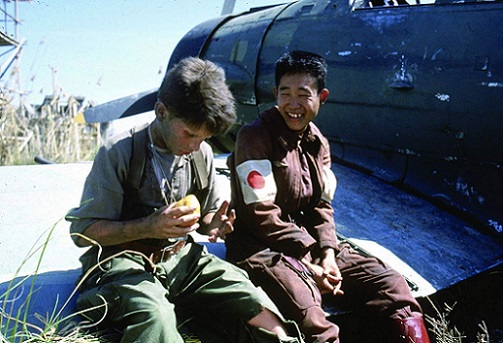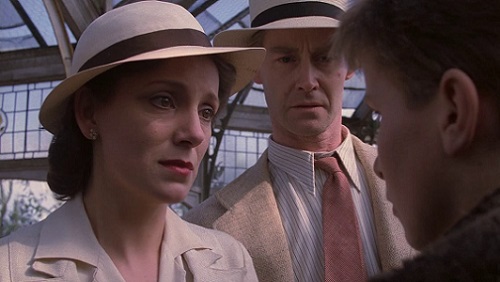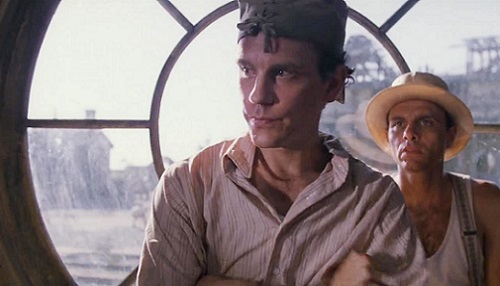British, American and other expatriates were in Shanghai, China during the time surrounding the Japanese occupation of the city during the Second Sino-Japanese War. That war lasted longer and occurred at the same time that many in the west understand as World War Two, though the film Empire of the Sun (1987) looks at the period that can be roughly understood as 1941 to 1945.
 (Christian Bale as Jamie ‘Jim’ Graham and Takatarô Kataoka as Kamikaze Boy Pilot in the film Empire of the Sun).
(Christian Bale as Jamie ‘Jim’ Graham and Takatarô Kataoka as Kamikaze Boy Pilot in the film Empire of the Sun).
The film Empire of the Sun tells the story of spoiled British child Jamie Graham, played by Christian Bale, who starts the film living with his parents in diplomat accommodations in Shanghai prior to the Japanese attack on Pearl Harbor. Jamie has lived an exceptionally privileged life with Chinese servants serving his every wish, having grown up in diplomatic circles in China with an apparent understanding of communicating in both English, the form of Chinese spoken in Shanghai, and Japanese.
 (Left to Right, Emily Richard as Mary Graham, Rupert Frazer as John Graham and Christian Bale as Jamie ‘Jim’ Graham in the film Empire of the Sun).
(Left to Right, Emily Richard as Mary Graham, Rupert Frazer as John Graham and Christian Bale as Jamie ‘Jim’ Graham in the film Empire of the Sun).
In the chaos following Japan occupying Shanghai and the attack on Pearl Harbor, Jamie is separated from his parents as the occupation begins. Following some desperate actions in the aftermath of that chaos, Jamie becomes entangled in the occupation with American expatriates Frank Demarest and Basie, as portrayed by John Malkovich and Joe Pantoliano.
 (John Malkovich as Basie, left, and Joe Pantoliano as Frank Demarest in the film Empire of the Sun).
(John Malkovich as Basie, left, and Joe Pantoliano as Frank Demarest in the film Empire of the Sun).
In creating a trade network within the camp where the prisoners exist, and in coming of age in a fashion that instills hope among the adult prisoners where all are held, Jamie takes the abbreviated name Jim from Basie and Frank. Hope comes in the form of the successes in acquiring street smarts, flat out bravery in pushing boundaries with his captors for his own good as well as the benefit of the prisoners, and the support Jim acquires through the course of the movie’s telling.
 (Nigel Havers as Dr. Rawlins, left, and Christian Bale as Jamie ‘Jim’ Graham in the film Empire of the Sun).
(Nigel Havers as Dr. Rawlins, left, and Christian Bale as Jamie ‘Jim’ Graham in the film Empire of the Sun).
While in the camp, Jim also forms a sort of father and son relationship with camp physician and British expatriate Dr. Rawlins, as portrayed by Nigel Havers. The bond formed by the two is palpable and convincing, offering a sweet glimpse into the emotionally possible within the context of the utterly miserable conditions of captivity. It is in part that Jim can maintain an optimism and growth in the face of a military occupation that hope is as strong a message for Empire of the Sun as is captivity.
 (Christian Bale and Empire of the Sun director Steven Spielberg on set of the film Empire of the Sun).
(Christian Bale and Empire of the Sun director Steven Spielberg on set of the film Empire of the Sun).
The film Empire of the Sun is based on J.G. Ballard‘s autobiographical novel, also named Empire of the Sun. The film ends during the 1945 liberation of the prison camp, with glimpses of the atomic bomb in Nagasaki catching Jim’s attention. The heavy truths are shared in typically tasteful Steven Spielberg fashion, and the story eventually resolves in emotionally compelling fashions on that larger stage as well as on the personal stage of the relationships forged through the film. Empire of the Sun, rather to my unexpected pleasure, works on an emotional level in the storytelling that allows me to give the film 4.00-stars on a scale of one-to-five.
Matt – Wednesday, January 8, 2020


 (Alice Walker, the writer of the book The Color Purple, winner of the Pulitzer Prize and the National Book Award).
(Alice Walker, the writer of the book The Color Purple, winner of the Pulitzer Prize and the National Book Award). (Whoopi Goldberg as Celie Johnson in the movie The Color Purple).
(Whoopi Goldberg as Celie Johnson in the movie The Color Purple). (Danny Glover as Albert Johnson in the movie The Color Purple).
(Danny Glover as Albert Johnson in the movie The Color Purple). (Akosua Busia as Nettie Harris in the movie The Color Purple).
(Akosua Busia as Nettie Harris in the movie The Color Purple). (Oprah Winfrey as Sofia in the movie The Color Purple).
(Oprah Winfrey as Sofia in the movie The Color Purple). (Willard E. Pugh as Harpo Johnson, left, and Oprah Winfrey as Sofia in the movie The Color Purple).
(Willard E. Pugh as Harpo Johnson, left, and Oprah Winfrey as Sofia in the movie The Color Purple). (Whoopi Goldberg as Celie Johnson, left, and Margaret Avery as Shug Avery in the movie The Color Purple).
(Whoopi Goldberg as Celie Johnson, left, and Margaret Avery as Shug Avery in the movie The Color Purple). (Whoopi Goldberg, left, and producer/director Steven Spielberg between takes of the movie The Color Purple).
(Whoopi Goldberg, left, and producer/director Steven Spielberg between takes of the movie The Color Purple).